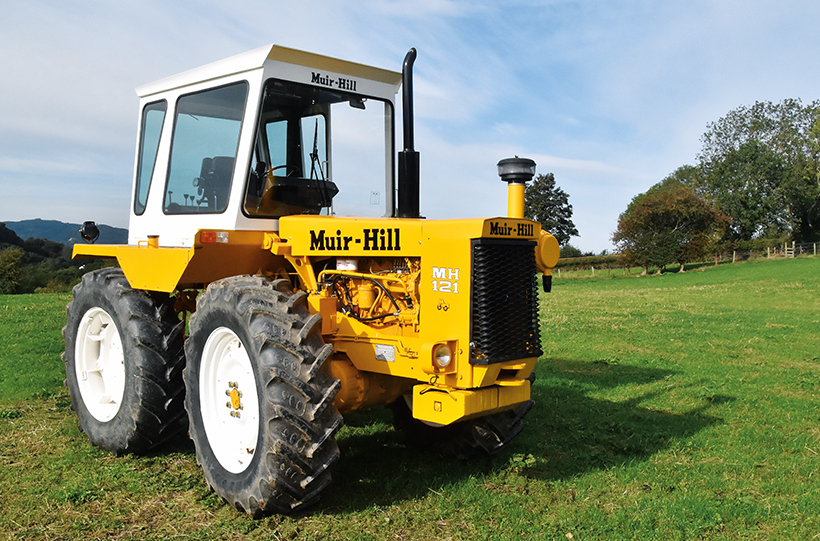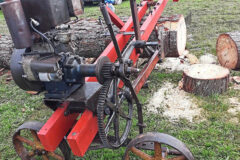1979 Muir-Hill 121
Posted by Chris Graham on 7th February 2024
Bob Weir visits one of the stand-out tractors that he spotted at the 2023 Shrewsbury Steam Rally – a 1979 Muir-Hill 121.

The Muir-Hill 121 certainly stands out from the crowd and does not give many clues to its Ford roots. This 1979 Series III model is owned by David Francis.
David Francis has lived in Powys, Mid-Wales, all his life and runs his own construction company, MP Paver Hire & Surfacing Ltd. “I was brought up in the country,” he told me, “and when I finished school, I worked on a local farm until I was 21. I then went to Australia for a year and spent a lot of the time on building sites.
“When I came home, I decided to work in the construction industry. My company specialises in paving and other surfaces. We carry out a full range of tarmacadam and surfacing services for a range of customers, from domestic properties and agricultural clients through to schools, local authorities, and commercial businesses.”
David’s interest in tractors comes from his rural background and working on the local farm. “The farm had this old Fordson Major, which they were using as a scraper tractor,” he explained. “I bumped into the owner a few years later, and he told me he was thinking of scrapping the machine. I went to have a look at it, and we managed to come to an arrangement.
“It certainly needed a lot of TLC, and I decided to give it a makeover,” he said. “I did some of the work on the Fordson myself, but in recent years have used a local company over in Shrewsbury. We also have a Roadless and a couple of Ford Series 10 tractors that are looked after by my son, Jack.”
David’s fondness for Muir Hill also dates to his farming days, back in the late 1970s. “The neighbouring farmer was a contractor and specialised in liquid fertiliser,” he recalls. “He had a couple of Muir-Hills, which he used for different jobs. I was impressed by the bulk and size of the tractor compared to our farm’s Fordsons and Nuffields.”
Fast forward to 2012 and David attended a Ford conversions day at Lincoln. “I went along with a friend of mine, who owns a Muir-Hill 121 and County 1454,” he explained. “By this stage I had acquired a Fordson-based Roadless, so we each took our own tractors.”

Lurking under the bonnet is a turbocharged, 5.9-litre Ford engine from a Muir-Hill 141.
County vs Muir-Hill
“My friend had already asked me an interesting question. Given the choice, would I take his County over the Muir-Hill? Knowing County’s reputation, I’d said ‘yes’. He suggested that when we got to the show, I should try both the County and Muir-Hill out with a plough, and he’d ask me again.”
Having taken up the challenge, David was surprised to find he preferred the Muir-Hill 121. “I found it easier to drive,” he said. “The gear changes were slick and straightforward, and there was great visibility. There was also the more efficient turning circle, which is Muir-Hill’s speciality. I came away from Lincoln thinking I must get one of these tractors.”
Muir-Hill was an engineering company initially based at Trafford Park in Manchester, established in the 1920s, producing accessories for the Fordson tractor and involved with the building of railway locomotives, shunters, and plant – including Fordson-based dumper trucks.
The company launched a four-wheel drive tractor in 1966, using a Ford six-cylinder engine and Ford 5000 gearbox. Dubbed the 101, due to its power output, Muir-Hill followed in the footsteps of County and Roadless by using mostly Ford parts.
The 101 featured equal-sized wheels, with the front driven by a propshaft from the transfer box located between the gearbox and rear axle casings. The size of the front axle meant that the tractor was higher than normal, but this considerably improved traction. The 101 was subsequently followed by several other six- and eight-cylinder heavyweights, including the 121.
Muir-Hill changed hands several times during its lifespan and tractor production stopped during the 1980s. The name is currently owned by Lloyd Loaders (MH) Ltd., which provides service, parts, and restoration services.
“Once I got home from Lincoln, I started looking around for either a 121 or 141,” said Dave. “I wasn’t fussed one way or the other, and it was a case of whichever came along first. Shortly afterwards, I saw OAA 973T being advertised in a magazine. The owner lived down in Devon, so I phoned the number. Me and Jack ended up making a visit, and after taking the tractor for a spin, managed to come to an arrangement.”

David Francis finds his Muri-Hill 121 easy to drive, thanks to its slick gearbox and great visibility. He also appreciates the efficient turning circle; a Muir-Hill speciality.
Dave then arranged to have the tractor delivered back home as part of a return load. “This took a few weeks, but we weren’t in any hurry,” Dave recalls. “Although the tractor was in reasonable condition, it still needed a spot of work. The Muir-Hill had been living by the sea, and the salt had got into the bodywork. The tractor also needed rewiring.”
Dump trailer
According to Dave, the previous owner had kept the tractor for 20 years. “For most of that time it was kept on a dump trailer, and hadn’t done any linkage work,” said Dave. “Before that it was being used in the China Clay mines
on more dump trailer duties. The Muir-Hill must have been worked hard, as the original engine had been replaced at some point by a turbo unit out of a 141.”
Dave also recalls that the previous owner had some fun and games with the 121. “Apparently, he had fitted wheel weights at the back to improve the tractor’s stability,” he said. “He soon discovered that with the extra power from the bigger engine, the grip was so intense that he kept ripping the wheel lugs off the centre of the wheels. In the end he welded steel plates onto the rim and dish to strengthen things up, and this seemed to work.”
Dave was busy running his business at that point, so he decided to have the restoration done at Lloyd Loaders (MH) Ltd. “We delivered the Muir-Hill to Yorkshire and basically told them to get on with it,” he said. “They did the work in-between other jobs, and we got the tractor back in 2020.”
Now that it was finally back in Mid-Wales, OAA 973T was not allowed to rest on its laurels. “Lloyd Loaders had restored the tractor to showroom condition, but I’m of the belief that machines like the Muir-Hill are there to be used,” said Dave. “For example, this summer OAA 973T has been on the batwing topper, and our tri-axle low-loader trailer.”
Dave also uses the Muir-Hill at working days, like the Shrewsbury Steam Rally at Onslow Park. “This was its first time out at Onslow,” he explained. “I’d been meaning to take it for a few years, and it performed well. The tractor is straightforward to drive and easy to operate. I’m glad we made the investment to restore the Muir-Hill and am looking forward to using it for the foreseeable future.”
Model history
Muir-Hill’s ground-breaking 101 tractor had been on sale for six years when its replacement was announced, in 1972. The 121, part of the new Series II range, retained the popular Ford 2715E engine and 5000’s gearbox, while adding a new flat floor cab and larger fuel tank. The cab was mounted on rubber pads to decrease the noise and vibration. It was also fitted with a new sliding door, and drivers appreciated the extra room and all-round view.

Series III tractors had an assistor ram fitted as standard.
The new 121 certainly had plenty of competition from the likes of the Roadless Ploughmaster 120 and County 1164, but where it had an advantage was more power and a tighter turning circle. At 31ft, this was a bonus at the headland.
All three heavyweights relied greatly on Ford parts, although the 121 also used some in-house components that set it apart from the competition. These included the transfer box (or dropbox), that enabled the purpose-built front axle to fit under the engine – improving the turning circle. On the downside, this resulted in a loss of 30hp, or a quarter of the Series II’s output.
Despite being over-engineered, the transfer box worked well until something went wrong. Repairs could be expensive, so owners were advised to properly maintain their machines.
The hydraulics and linkage were all Ford. These were well designed, but came from the respective base model.
This meant that, despite the 121’s six-cylinder engine, they were often working under strain and struggled to lift larger implements. Later versions were fitted with an assistor ram, which went some way to solving the problem.
The Series III range came out in 1978 and was a serious upgrade. Improvements included a revised cab, featuring better noise insulation and air filtration, and the operator also had more power at his/her disposal, thanks to the engine being upgraded to 132hp. By now, Ford’s 7600 gearbox was being utilised, with Dual Power and two-speed PTO as options.
The superior front axle gave the 121 an edge over its rivals; that and the fact it was different from other Ford derivatives. And although the Roadless and County machines still attract a premium, the yellow Muir-Hill is more than capable of holding its own.
This feature comes from the latest issue of Tractor & Machinery, and you can get a money-saving subscription to this magazine simply by clicking HERE

Previous Post
The resurrection of an amazing Boothmac Dragsaw

Next Post
Iconic JCB celebrates its 70th birthday in style!



